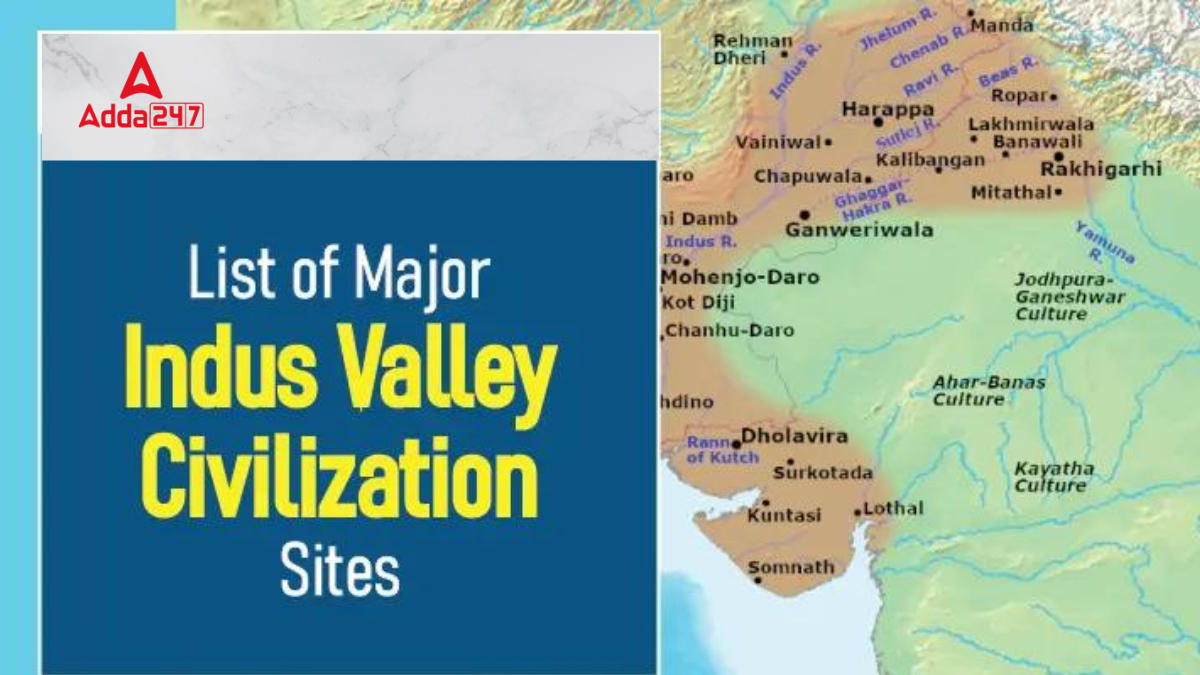Table of Contents
A list of Indus Valley Civilization sites provides valuable information about the date of discovery, the location of Harappan sites, and key findings at these locations. These sites are significant for the UPSC Prelims Exam (Ancient Indian History) and the UPSC Mains Exam (GS Paper 1 – Indian History), covering the salient aspects of Indian culture, including art forms, literature, and architecture from ancient to modern times
Indus Valley Civilization
Indian history began at the same time when the Indus Valley Civilization (IVC) emerged. It is estimated that the Indus Valley Civilization (also known as the Harappan Civilization) flourished from 3300 to 1300 BCE. The Indus Civilization reached its mature state between 2600 and 1900 BCE.
The 1900 BCE – 1500 BCE period saw the decline of the Indus Valley Civilisation which coincided with a wave of migration of the Aryan people from the north, most likely the Iranian Plateau.
List of Major Sites of Indus Valley Civilization/Harappan Civilization
The first site of the Indus Valley Civilization was Harappa, which was founded in the 1920s by Madho Sarup Vats, Rai Bahadur Daya Ram Sahni, and Marshall. The discovery of Mohenjo-daro is located in the Sindh (Sind) region near the Indus River. A list of Major Harappan Sites, their discovery, and Key artefacts found at these sites are mentioned below-
| Year | Site | Discovered by | Location | Features |
| 1921 | Harappa | Marshall, Rai Bahadur Daya Ram Sahni and Madho Sarup Vats. | Located in the Montgomery district of Punjab, on the banks of the Ravi River. |
|
| 1922 | Mohenjodaro | R.D. Banerjee, E. J. H. MacKay and Marshall. | Located in the Punjab district of Larkana on the banks of the Indus River |
|
| 1929 | Sutkagendor | Stein | Dast river in Pakistan’s southern Balochistan province |
|
| 1931 | Chanhudaro | N.G Majumdar | Sindh is located on the Indus River. |
|
| 1935 | Amri | N.G Majumdar | On the banks of the Indus. |
|
| 1953 | Kalibangan | Ghose | Rajasthan, beside the Ghaggar River. |
|
| 1953 | Lothal | R.Rao | Gujarat on the Bhogva river near the Gulf of Cambay. |
|
| 1964 | Surkotada
|
J.P Joshi | Gujarat. |
|
| 1974 | Banawali | R.S Bisht | Haryana’s Hisar district. |
|
| 1985 | Dholavira. | R.S Bisht in | Gujarat, Rann of Kachchh. |
|
The Indus civilization, also known as the Indus Valley civilization or Harappan civilization, was the Indian subcontinent’s first known urban culture and one of the world’s three early civilizations (the others being Mesopotamia and Egypt). Sophisticated settlements and the development of trade and society are the key features of the Harappan Civilization.
Important Cities in Indus Valley Civilization
The Indus Valley Civilization (IVC) was one of the world’s earliest urban civilizations, flourishing around 3300 BCE to 1300 BCE in what is now Pakistan and northwest India. Among its numerous settlements, seven cities stand out due to their size, urban planning, and archaeological significance: Mohenjo-Daro, Harappa, Kalibangan, Lothal, Chanhudaro, Dholavira, and Banawali. Each of these cities provides unique insights into the life, culture, and technological advancements of the Indus Valley people.
Mohenjo-Daro
Mohenjo-Daro, located in Sindh, Pakistan, is one of the most significant and well-preserved cities of the IVC. Key features include:
- Urban Planning: The city was laid out in a grid pattern, with streets intersecting at right angles, reflecting advanced urban planning.
- The Great Bath: This large, public bathing area suggests the importance of ritualistic and hygienic practices.
- Granary and Warehouses: Indicating organized storage and distribution of food.
- Drainage System: An extensive network of covered drains and sewers, showcasing advanced engineering.
Harappa
Harappa, situated in Punjab, Pakistan, was another major city of the IVC. It shares many features with Mohenjo-Daro, highlighting a standardized approach to urban development. Notable aspects include:
- Citadel and Lower Town: Harappa was divided into a fortified upper town (citadel) and a lower town, reflecting social stratification.
- Artifacts: Advanced craftsmanship in bead-making, pottery, and metallurgy.
- Granaries: Large granaries similar to those in Mohenjo-Daro, indicating a focus on food storage and distribution.
Kalibangan
Kalibangan, located in Rajasthan, India, is notable for its unique urban features and evidence of early agricultural practices. Significant aspects include:
- Ploughed Fields: Evidence of furrows, indicating early agricultural techniques.
- Fire Altars: Suggesting ritualistic practices.
- Defensive Walls: The city had fortifications, indicating a concern for defense and security.
Lothal
Lothal, located in Gujarat, India, was a significant port city of the IVC. Its maritime activities are particularly noteworthy. Key features include:
- Dockyard: One of the world’s earliest known dockyards, suggesting extensive trade and commerce.
- Bead Factory: Evidence of a well-developed bead-making industry.
- Seal Impressions: Numerous seals indicating a system of weights and measures for trade.
Chanhudaro
Chanhudaro, located in Sindh, Pakistan, is distinguished by its specialized industries. Unlike other cities, it was not heavily fortified. Key aspects include:
- Craftsmanship: Evidence of bead-making, shellworking, and metal craftsmanship.
- Urban Planning: Although smaller, Chanhudaro had well-planned streets and drainage systems.
- Absence of Fortifications: The city was likely a centre of production rather than a military stronghold.
Dholavira
Dholavira, situated in Gujarat, India, is unique for its water conservation systems. Discovered in the 1960s, Dholavira features:
- Water Management: Large reservoirs and an intricate system of water channels, are crucial for a city located in a semi-arid region.
- Large Stadium: Evidence of large open spaces that could have been used for gatherings, rituals, or possibly sports.
- Distinctive Layout: Divided into three sections – the citadel, middle town, and lower town.
Banawali
Banawali, located in Haryana, India, provides insights into both urban planning and rural life within the IVC. Notable features include:
- Circular Houses: Unlike the rectangular houses common in other IVC sites, Banawali had circular houses.
- Agricultural Tools: Numerous tools indicate a significant focus on agriculture.
- Granaries and Fortifications: Similar to other IVC cities, Banawali had storage facilities and defensive structures.
Check: All UPSC History Notes



 Sources of Mauryan History: Literary and...
Sources of Mauryan History: Literary and...
 Dr. Ram Manohar Lohia: Indian Socialist,...
Dr. Ram Manohar Lohia: Indian Socialist,...




